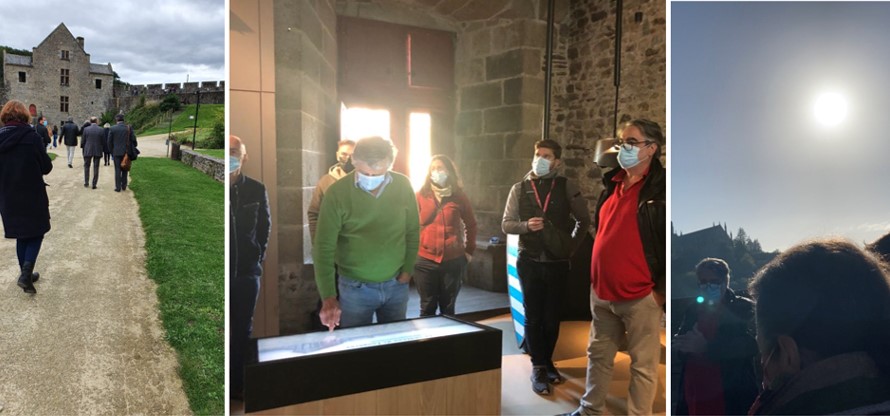VISTA AR presented 4 years of work to the Breton public at the final event of the project last October

The partners of the Interreg France (Channel) England VISTA project celebrated the end of the project and the launch of the devices at the fabulous Château de Fougères under the bright sunshine of Brittany, on 20-22 October.

On Wednesday 20th, final Quarterly Meeting with partners, in Rennes, summed up the project’s successes, highlighting that all the outputs had been achieved despite the constraints of Brexit and COVID. You can find the slides of presentation HERE.
The next day, EESAB (Brittany European School of Art) welcomed us again. The day started with a morning of presentations about the project to the public, followed by an afternoon of demonstrations of AR and VR devices developed for cultural heritage sites over the last four years, including the VR of the plank or “walk of faith”, which was again a great success, and a scale model reproduction of the Château de Fougères. There was also the opportunity to showcase the visitor intelligence tools created by the University – Visitor Intelligence text analytics dashboard, FR interactive Business Model Innovation Workbook (UoE and NEOMA Business School) and Eye Tracking studies – and by CESI (Centre of Higher Education and Professional Training) – a visitor app with geolocation capacity.
The audience (twenty or so former and current Art school students and professionals from the tourist and cultural heritage sector) actively participated in the morning by asking numerous pertinent questions; the time allocated to the demonstrations then facilitated exchanges and created new contacts

Presentations in the morning at EESAB

Demonstrations in the afternoon: meetings with the public and presentation of the AR on a scale model of the Castle, and RV of the plank
Friday was spent at the Château de Fougères, where the final VR devices were launched to the public composed of local elected officials, including the Mayor of the town, various stakeholders in the project and the press. Listening to history-laden presentations of Samuel Linard (the town’s heritage coordinator) and Elise Balch (head of the heritage and tourism department), VIP visitors were able to see the augmented reality application that recreates the castle through the ages from a stone model, as well as the scientific and historical reconstruction in AR of the Logis as it would have been seen centuries before.
 Public in front of the stone model
Public in front of the stone model
The VR experience featured a fly-over of the Château during different time periods and an Immersive Room showing an animated, medieval battle. In front of local dignitaries and under the camera of journalists, Professor Smart gave a speech on how Visitor Intelligence tools allow sites to measure the impact of these technologies on the visitor experience, Professor Mahé went on to explain how his team developed the technologies, and the designer Agnès Badiche was there to showcase the ‘PMR room’ (for visitors with reduced mobility). Forty VIPs were present on the 22nd and, like the day before, showed great enthusiasm for the experiences presented and the VISTA project as a whole.

Meeting with the Mayor of Fougères

The room for people with reduced mobility and its immersive heaumes
The Immersive Room
As well as being an excellent way to wrap up the project, it was a great feeling to be able to see our colleagues after nearly 2 years of remote working, having overcome some significant challenges. The visit underlined the reason that the project was established in the first place, to create a collaborative research partnership where varied partners from two different countries were able to learn from, and inspire each other.
